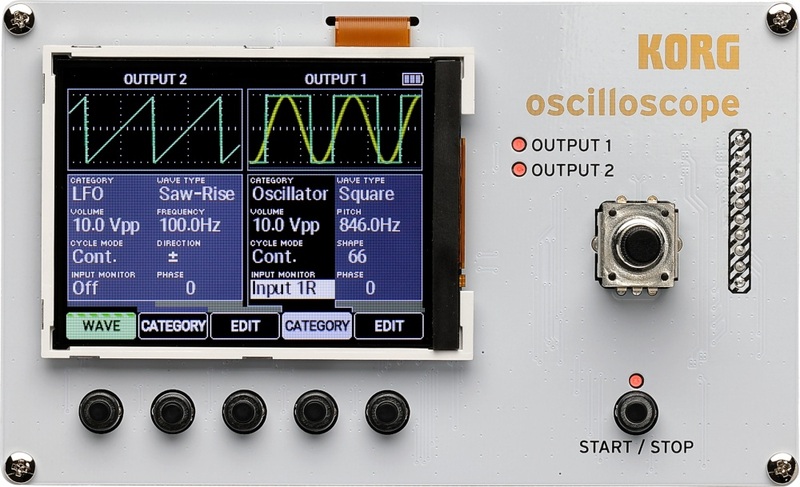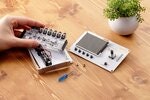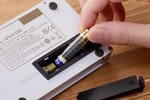KORG NTS-2 - NuTekt Oscilloscope Kit
Artikelnummer 8010347Bygg ditt eget oscilloskop med denna lättmonterade byggsats!
Nu:Tekt NTS-2 - Bygg ditt eget oscilloskop!
NTS-2 är ett 4-kanals oscilloskop som visar både styrspänning (CV) och ljudsignaler. Den har också en flexibel vågformsgenerator, en spektrumanalysator och en tunerfunktion.
Oavsett vilken nivå av teknisk kunskap du befinner dig på har du här ett pålitligt verktyg för exakta referenser till den musik du skapar.
Nu:tekt - DIY
Nu:tekt är en serie med produkter i kompakt format med DIY-tänket, det är helt enkelt byggsatser där du själv, på ett enkelt sätt monterar ihop ditt instrument. Monteringsanvisningen är tydlig, monteringen enkel, nödvändiga verktyg ingår och ingen lödning krävs. Ett kul och kreativt sätt att skapa ett instrument att skapa musik med.
A studio must-have
The NTS-2 kit is compact and easy to assemble (*), but don’t let its size fool you – it packs a real punch! The NTS-2 is an oscilloscope, tuner, FFT, and spectrum analyzer that is accurate, intuitive, and incredibly useful. But that’s not all – using its dual stereo IN, dual stereo THRU/OUT, and two separate OUTPUTs, you can wire it into your synth rig and use its dual waveform generators to give yourself an extra pair of oscillators or LFOs! It’s the ideal tool for every synth lover and modular user – from beginner to pro.
(*) No soldering needed, the assembly process requires less than 20 minutes
The best companion for synth learners
Even though synthesizers are musical instruments first and foremost, learning about them is easier and more intuitive if we can use our eyes to supplement our ears. Studying waveforms, frequency and time relationships, audio signals, and control voltages become clear and immediate if we can see how they change and interact, not just listen to what they’re doing. Seeing these signals come alive in full color as we patch and tweak gives our learning process a huge boost!
The oscilloscope, a tool for visualizing signals and voltages, has been around for many years – but as scientific instruments, they might not seem like something a musician could easily use. Not anymore – for the first time, an oscilloscope has been designed with the musician in mind! The NTS-2’s interface is simple, clean, and easy to use; rather than twiddling knobs and trying to understand obscure parameters, you can look at your signals and understand them in a matter of seconds. That way, your artistic focus can remain where it belongs: on making your music.
A useful toolset for musicians
The NTS-2 includes a variety of useful studio functions, all in a pocket-sized, elegant package that you can take anywhere.
4 CHANNEL OSCILLOSCOPE
With its dual stereo inputs, you can study up to four signals at once, comparing and overlapping them with ease. A variety of display modes let you see your data in color, a huge advantage over the old oscilloscopes you’ve seen in science fiction movies! Its user interface is clear and quick, thanks to its dedicated menu buttons and clickable encoder knob, and its 240 x 320 pixel 2.8” color LCD is a joy to watch.
NTS-2 even has a powerful Lissajous mode - opening the door to creativity and making it possible to visualize widely available oscilloscope art, for extra fun with your device.
FFT / SPECTRUM ANALYZER
To further dive into analyzing any signal, the NTS-2 also comes with a dedicated FFT (Fast Fourier Transform) mode with a real-time Spectrum Analyzer. These handy tools have always been out of reach for the synth musician because they either required expensive hardware or a nearby computer. Now you can carry them in your pocket!
DUAL WAVEFORM GENERATOR
But the NTS-2 is much more than just an oscilloscope. The flexible Wave Generator mode has 2 oscillators with dedicated outputs, so you can test your synth rig or just get creative! Each oscillator can create a variety of waveforms – sine, square, triangle, sawtooth, pulse, and noise – whose shape and phase can be adjusted to suit many applications.
These sounds can be used in the audio range or as control voltage sources, and they can be set to cycle continuously or act as one-shot impulses; that means you can turn them into LFOs, envelopes, triggers, and control voltage generators, as well as sound sources. Attaching the NTS-2 to any patchable synthesizer instantly expands its power in useful ways, making it an analog synth player’s dream tool.
TUNER
And of course, coming from KORG, this multi-functional utility kit wouldn’t be complete without a precise and easy-to-use Tuner with multiple display modes!
Being able to receive and monitor up to 4 input signals at the same time, the NTS-2 is an analog synth player’s dream tool.
Connectivity and ease of use
The NTS-2 offers plenty of ways to connect to your studio, despite its small footprint. Besides its 4-channel input and dual waveform output features, its dual stereo THRU/OUT ports let you leave it wired into your system. It’s much easier to understand what you’re doing if you can see the signals and use them at the same time, rather than constantly plugging and unplugging cables. This handy function lets you maintain your signal flow at all times – even when the NTS-2 has been powered off.
Speaking of power, the NTS-2 maximizes portability and flexibility by using either batteries or a USB-C power supply, depending on your needs.
Nu:Tekt DIY fun
As with other Nu:Tekt products, the NTS-2 is a DIY (Do It Yourself) kit that is extremely easy and quick to assemble.
Important Notice:
- The NTS-2 oscilloscope kit is a stand-alone kit and does not include the “PATCH & TWEAK with KORG” book, nor the exclusive side panels and stickers that were included in the bundle.
- The “PATCH & TWEAK with KORG” book on its own (*) is readily available for purchase at www.bjooks.com and from resellers internationally.
Specifications:
- Dimensions 12.9 x 7.8x 3.9 cm
- Weight 130g (not including batteries)
- Power USB type-C (2.0, 500mA max) or 2x AAA batteries (approx 2 hours running time)
- Input: 3.5mm Stereo x2, ±10V max
- Through Output: 3.5mm Stereo x2
- Output: 3.5mm Mono x2, ±5V max
Oscilloscope
- Display modes: Single, Stereo (Input1L-INPUT1R, Input1L - Input2L, Input2L - Input2R), 4ch、XY(Lissajous, 2ch)
- Vertical: 10mV~5V/div, AC/DC MODE switchable
- Horizontal: 50us~1s/div
- Trigger: Auto, Rise, Fall, Single(rise), Single(fall)
- FFT (Spectrum Analyzer)
- Input: mono (1L, 1R, 2L, 2R)
- Frequency 20Hz~20kHz
Function Generator
- Wave type: sine, square, triangle, saw, noise, pulse, envelope
- Frequency: 1Hz~10kHz, Hz/NOTE mode switchable, [1ms~10s,sec/BPM switchable(pulse, envelope mode)]
- Output level: 10Vpp max, V/dB mode switchable
Tuner
- Display mode: Needle, Meter
- Input: Mono, Stereo (Input1L-Input1R, Input1L-Input2L)
- Calibration: 410-480Hz
KORG - Innovation sedan 60-talet
Korg grundades i Japan under det tidiga 60-talet av Tsutomu Katoh och hans kollega Tadashi Osanai. Företaget hette från början Keio Electronic Laboratories och flyttade in i sina första lokaler 1962. Namnet Keio valdes eftersom det innehöll initialerna i de båda grundarnas efternamn. Det var också namnet på den järnvägslinje som passerade precis utanför fönstret på deras verkstad.
1963 introducerades Katohs och Osanais förstlingsverk Doncamatic DA-20, en elektrisk rytmbox baserad på ett system med roterande diskar. DA-20 fick en efterföljare i DA-11, en allt igenom elektronisk DoncaMatic-modell.
Ett par år senare kontaktades Katoh av Fumio Mieda, en ingenjör som ville bygga en ny typ av orgel. Till skillnad från de flesta av dåtidens orglar var Miedas version programmerbar. Även fast han själv använde ordet orgel hade Mieda i praktiken konstruerat en synthesizer. Femtio exemplar tillverkades och såldes under det nya namnet Korg som var en sammandragning av namnet Keio och Organ (engelska för orgel, som bekant).
Under 70-talet utvecklade Korg en mängd synthesizermodeller som Mini Korg, PE-1000 Polyphonic Ensamble och MS-20. Företaget begränsade sig inte bara till olika synthesizers. 1975 lanserade man världens absolut första stämapparat i fickformat, WT-10, en produkt som sedan dess fått otaliga efterföljare.
1981 kom PolySix, en synthesizer som var unik såtillvida att den var både programmerbar, polyfonisk och (kanske viktigast av allt) så billig att i stort sett vem som helst hade råd att köpa en. Ytterligare ett stort utvecklingssteg togs 1988 med Korg M1, en synthesizer som innehöll realistiska samplingsbaserade ljud, trummaskin, sequencer och digital effektenhet, allt kombinerat i ett instrument - världens första workstation, kort sagt.









